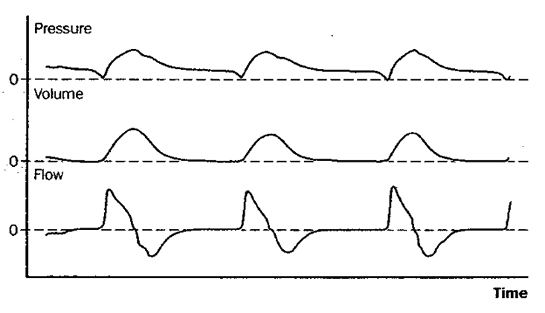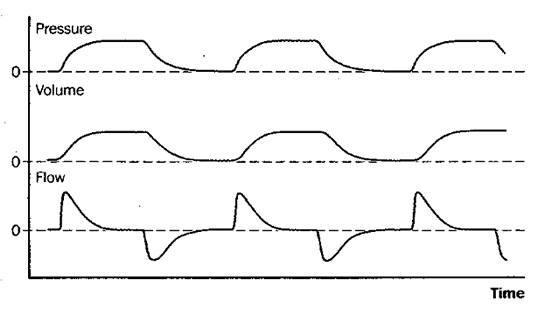Pressure-Targeted Modes
A number of modes are available that preset the maximum inflation pressure rather than a fixed Vt. Most widely used among these are pressure support ventilation (PSV) and pressure control ventilation (PCV), illustrated in Figures 5 and 6.
With PSV, the patient breathes spontaneously and is assisted with every breath to a preset inspiratory pressure target. Although the technical aspects of its delivery are different, this is conceptually the same as intermittent positive-pressure breathing (IPPB), used in the past as a means of ventilatory support but now primarily an adjunct to lung-expansion maneuvers for preventing or treating atelectasis. Pressure support can be combined with SIMV, so that when the patient takes a spontaneous breath, over and above the set frequency of mandatory volume-targeted breaths, inspiration is assisted to the set pressure support level.
Similar to CMV, in PCV the rate is fixed and cannot be increased by patient effort, but a difference is that it is the peak inflation pressure rather than the Vt that is set. Technically, the term for this mode is pressure-controlled continuous mandatory ventilation. On some ventilators it is also possible to deliver pressure-controlled A/C ventilation and pressure-controlled SIMV. Pressure-controlled inverse ratio ventilation (PCIRV) is not a separate mode, but rather PCV with the inspiratory phase longer than expiration. This variant of PCV has been used in patients who have severe hypoxemic respiratory failure in an attempt to improve oxygenation, but its popularity has waned because of the high incidence of hemodynamic compromise and barotrauma.
Fig 5: pressure support ventilation (PSV)

Figure 5: Schematic depiction of changes in pressure at the airway opening, lung volume, and flow during pressure support ventilation (PSV). Pressure support is essentially spontaneous breathing with a preset positive pressure boosting each inspiration. Patients on PSV receive no ventilation if apnea occurs.
Fig 6: pressure control ventilation (PCV)

Figure 6: Schematic depiction of changes in pressure at the airway opening, lung volume, and flow during pressure control ventilation (PCV). Pressure control ventilation is analogous to controlled mechanical ventilation (CMV, Figure 2), in that the rate is fixed and the patient cannot trigger additional breaths or breathe spontaneously between mandatory breaths; it differs from CMV in that maximum inspiratory pressure rather than tidal volume is fixed, and both tidal volume and minute ventilation can vary if the patient’s lung-thorax compliance or airway resistance changes.
A key distinction between volume- and pressure-targeted modes relates to what happens when the mechanics of the patient-ventilator system change. When a patient who receives volume-targeted ventilation develops a pneumothorax or partial airway obstruction by inspissated secretions, the same Vt is delivered as before, but at higher peak and static airway pressures. However, with pressure-targeted ventilation, maximal airway pressure is preset and cannot increase under these circumstances. Instead, with obstruction in the airway or a decrease in compliance, the pressure stays the same and the delivered Vt decreases. Thus, the clinician needs to be aware that complications may be manifested differently in the different modes. When managing a patient whose pulmonary process may improve rapidly, as in acute asthma or pulmonary edema, the clinician needs to be prepared to make frequent ventilator adjustments when pressure ventilation is used.
Combined Modes
Most critical care ventilators of recent manufacture offer hybrid "modes" combining features of volume-targeted and pressure-targeted ventilation, in an attempt to avoid both the high peak airway pressures of volume ventilation and also the varying Vts that may occur with pressure ventilation. Manufacturers have attempted to make these combinations unique to their own machines in a competitive market, and as a result several apparently new modes have appeared on the scene. Essentially, these combinations consist either of volume ventilation with high inspiratory flow and a limitation on peak pressure, or of pressure ventilation regulated to provide a preset minute ventilation.
For example, recent Siemens/Maquet ventilator models offer pressure-regulated volume control (PRVC), in which all breaths are mandatory, the rate is fixed, and the inspiratory pressure is varied to maintain a preset Vt. These same ventilators also offer volume support, a combined mode that consists of PSV with a preset target Vt or minute volume, which the ventilator achieves by adding mandatory breaths, the inspiratory pressures of which are varied as necessary to achieve the set volume goal. Auto-mode, a third variation provided on recent Siemens/Maquet critical care ventilators, essentially combines PRVC and volume support. Auto-mode combines dual-control breath-to-breath time-cycled breaths with dual-control breath-to-breath flow-cycled breaths, patient effort or the lack thereof determining how individual breaths are cycled.
Each manufacturer features its own slightly-different blending of volume- and pressure-targeted modes. Other examples include auto-flow (Dräger), adaptive pressure regulation (Hamilton), and volume-assured pressure support (Bird). Automatic tube compensation (ATC), a feature of recent Dräger ventilators, is not a mode per se but rather an attempt to overcome resistive work of breathing added by the endotracheal tube. The operator enters the endotracheal tube diameter, and the ventilator applies positive pressure to overcome the desired proportion of calculated tube resistance via closed-loop control.
All these so-called combined modes are intended to give market advantage to the ventilator models that feature them. None has been demonstrated to have a detectable effect on clinical outcomes such as survival, complications, or weaning time.
In Table 5 [37k PDF*], a comparison is given of the most commonly used volume- and pressure-targeted ventilator modes in terms of their relative advantages and disadvantages.
 Top of Page
Top of Page
< Previous:
Volume-Targeted Modes | Next:
Positive
End-Expiratory Pressure (PEEP)